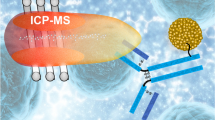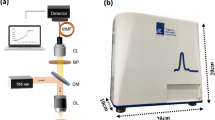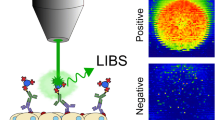Abstract
Successful treatment of cancers requires detecting early signs of the disease. One promising way to approach this is to develop minimally invasive tests for the sensitive and specific detection of biomarkers in blood. Irrespective of the detection approach one uses, this remains a challenging task because biomarkers are typically present in low concentrations and there are signals that interfere strongly with prevailing compounds of human fluids. In this paper, we show that elemental encoded particle assay coupled with femtosecond laser-induced breakdown spectroscopy for simultaneous multi-elemental analysis can significantly improve biomarker detectability. An estimated near single molecule per particle efficiency of this method leads to sensitive detection of ovarian cancer biomarker CA125 in human blood plasma. This work opens new ways for earlier detection of cancers and for multiplex assay developments in various analytical applications from proteomics, genomics, and neurology fields.





Similar content being viewed by others
References
Jemal A, Siegel R, Xu J, Ward E (2010) Cancer statistics. CA Cancer J Clin 60:277–300
American Cancer Society (2012). Cancer facts & figures 2012. American Cancer Society, Atlanta
Sturgeon CM, Duffy MJ, Stenman UH, Lilja H, Brünner N, Chan DW, Babaian R, Bast RC Jr, Dowell B, Esteva FJ, Haglund C, Harbeck N, Hayes DF, Holten-Andersen M, Klee GG, Lamerz R, Looijenga LH, Molina R, Nielsen HJ, Rittenhouse H, Semjonow A, Shih IM, Sibley P, Sölétormos G, Stephan C, Sokoll L, Hoffman BR, Diamandis EP (2008) National academy of clinical biochemistry laboratory medicine practice guidelines for use of tumor markers in testicular prostate, colorectal breast ovarian cancers. Clin Chem 55:e11–e79
McGuire V, Whittemore AS, Norris R, Oakley-Girvan I (2000) Survival in epithelial ovarian cancer patients with prior breast cancer. Am J Epidemiol 152:528–532
Lutz AM, Willmann JK, Drescher CW, Ray P, Cochran FV, Urban N et al (2011) Continuing medical education: early diagnosis of ovarian carcinoma: is a solution in sight? Radiology 259:329–345
Yurkovetsky Z, Skates S, Lomakin A, Nolen B, Pulsipher T, Modugno F, Marks J, Godwin A, Gorelik E, Jacobs I, Menon U, Lu K, Badgwell D, Bast RC Jr, Lokshin AE (2010) Development of a multimarker assay for early detection of ovarian cancer. J Clin Oncol 28:2159–2166
Davies C (2013) Principles of competitive and immunometric assays (including ELISA). In: Wild D, Kodak E, Squibb BM (eds) The immunoassay handbook: theory and applications of ligand binding, ELISA and related techniques, 4th edn. Elsevier, Oxford
Smith AM, Dave S, Nie S, True L, Gao X (2006) Multicolor quantum dots for molecular diagnostics of cancer. Expert Rev Mol Diagn 6:231–244
Freeman RG, Raju PA, Norton SM, Walton ID, Smith PC, He L, Natan MJ, Sha MY, Penn SG (2005) Use of nanobarcodes particles in bioassays. In: Rosenthal SJ, Wright DW (eds) Methods in molecular biology. Humana Press Inc, Totowa
Fulton RJ, McDade RL, Smith PL, Kienker LJ, Kettman JR (1997) Advanced multiplexed analysis with the FlowMetrix system. Clin Chem 43:1749–1756
Ahrends R, Pieper S, Kühn A, Weisshoff H, Hamester M, Lindemann T, Scheler C, Lehmann K, Taubner K, Linscheid MW (2007) A metal-coded affinity tag approach to quantitative proteomics. Mol Cell Proteomics 6:1907–1916
Koivunen ME, Krogsrud RL (2006) Principles of immunochemical techniques used in clinical laboratories. Lab Med 37:490–497
Markushin Y, Melikechi N (2012) Sensitive detection of epithelial ovarian cancer biomarkers using tag-laser induced breakdown spectroscopy. In: Farghaly SA (ed) Ovarian cancer—basic science perspective. InTech, Croatia
Markushin Y, Melikechi N, Marcano A, Rock S, Henderson E, Connolly D (2009) LIBS-based multi-element coded assay for ovarian cancer application. Proc SPIE 7190:719015
Boumans PWJM (1987) Inductively coupled plasma emission spectroscopy. Part II: applications and fundamentals. Volume 2. Wiley, New York
Miziolek AW, Palleschi V, Schechter I (2006) Laser-induced breakdown spectroscopy: fundamentals and applications. Cambridge University Press, Cambridge
Gurevich EL, Hergenroeder R (2007) Femtosecond laser-induced breakdown spectroscopy: physics, applications, and perspectives. Appl Spectrosc 61:233A–242A
Eland KL, Stratis DN, Gold DM, Goode SR, Angel SM (2001) Energy dependence of emission intensity and temperature in a LIBS plasma using femtosecond excitation. Appl Spectrosc 55:286–291
Baudelet M, Guyon L, Yu J, Wolf JP, Amodeo T, Fréjafon E, Laloi P (2006) Femtosecond time-resolved laser-induced breakdown spectroscopy for detection and identification of bacteria: a comparison to the nanosecond regime. J Appl Phys 99:084701
Gunaratne T, Kangas M, Singh S, Gross A, Dantus M (2006) Influence of bandwidth and phase shaping on laser induced breakdown spectroscopy with ultrashort laser pulses. Chem Phys Lett 423:197–201
Rohwetter P, Stelmaszczyk K, Wöste L, Ackermann R, Méjean G, Salmon E et al (2005) Filament-induced remote surface ablation for long range laser-induced breakdown spectroscopy operation. Spectrochim Acta Part B Atom Spectrosc 60:1025–1033
Niloff JM, Bast RC, Schaetzl EM, Knapp RC (1985) Predictive value of CA 125 antigen levels in second-look procedures for ovarian cancer. Am J Obstet Gynecol 151:981–986
Thomas CM, Massuger LF, Segers MF, Schijf CP, Doesburg WH, Wobbes T (1995) Analytical and clinical performance of improved Abbott IMx CA 125 assay: comparison with Abbott CA 125 RIA. Clin Chem 41:221–216
Yin BWT, Lloyd KO (2001) Molecular cloning of the CA125 ovarian cancer antigen. J Biol Chem 276:27371–27375
Drapkin R, Clauss A, Skates S (2008) Urokinase-type plasminogen activator receptor: a beacon of malignancy? Clin Cancer Res 14:5643–5645
Sivakumar P, Taleh L, Markushin Y, Melikechi N, Lasue J (2013) An experimental observation of the different behavior of ionic and neutral lines of iron as a function of number density in a binary carbon–iron mixture. Spectrochim Acta Part B 82:76–82
Wisbrun R, Schechter I, Niessner R, Schröeder H, Kompa KL (1994) Detector for trace elemental analysis of solid environmental samples by laser plasma spectroscopy. Anal Chem 66:2964–2975
Saarelainen SK, Peltonen N, Lehtimaki T, Perheentupa A, Vuento MH, Maenpaa JU (2013) Predictive value of serum HE4 and CA125 concentrations in endometrial carcinoma. Am J Obstet Gynecol 209:142e1–142e6
Bulatov V, Schechter I (2006) Plasma morphology. In: Vincenzo P, Israel S, Andrzej WM (eds) Laser-induced breakdown spectroscopy fundamental application. Cambridge University Press, Cambridge
Cremers DA, Radziemski LJ (2006) History and fundamentals of LIBS. In: Vincenzo P, Israel S, Andrzej WM (eds) Laser-induced breakdown spectroscopy fundamental application. Cambridge University Press, Cambridge
Wiklund M, Nord O, Gothall R, Chernyshev AV, Nygren PA, Hertz HM (2005) Fluorescence-microscopy-based image analysis for analyte-dependent particle doublet detection in a single-step immunoagglutination assay. Anal Biochem 338:90–101
Chunara R, Godin M, Knudsen SM, Manalisa SR (2007) Mass-based readout for agglutination assays. Appl Phys Lett 91:193902
Butch AW (2000) Dilution protocols for detection of hook effects/prozone phenomenon. Clin Chem 46:1719–1721
Schelp C, Pauly HE (2001) Detection methods. US20100311185 A1
Gubbels JAA, Belisle J, Onda M, Rancourt C, Migneault M, Ho M et al (2006) Mesothelin-MUC16 binding is a high affinity, N-glycan dependent interaction that facilitates peritoneal metastasis of ovarian tumors. Mol Cancer 5:50
UniProtKB/Swiss-Prot protein data base (2014) http://www.uniprot.org/uniprot/Q8WXI7. Accessed 5 Sept 2014
Lutz AM, Willmann JK, Cochran FV, Ray P, Gambhir SS (2008) Cancer screening: a mathematical model relating secreted blood biomarker levels to tumor sizes. PLoS Med 5:e170
Mongia SK, Rawlins ML, Owen WE, Roberts WL (2006) Performance characteristics of seven automated CA 125 assays. Am J Clin Pathol 125:921–927
Acknowledgments
This research was supported by grants from the National Science Foundation Centers of Research Excellence in Science and Technology (0630388) and National Aeronautics and Space Administration (NX09AU90A). We thank the Blood Bank of Delmarva for providing human blood plasma for the research.
Author information
Authors and Affiliations
Corresponding author
Rights and permissions
About this article
Cite this article
Markushin, Y., Sivakumar, P., Connolly, D. et al. Tag-femtosecond laser-induced breakdown spectroscopy for the sensitive detection of cancer antigen 125 in blood plasma. Anal Bioanal Chem 407, 1849–1855 (2015). https://doi.org/10.1007/s00216-014-8433-0
Received:
Revised:
Accepted:
Published:
Issue Date:
DOI: https://doi.org/10.1007/s00216-014-8433-0




